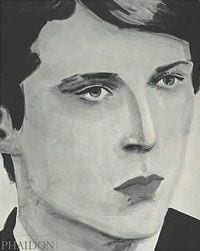
Elizabeth Peyton’s Live Forever is a retrospective of the artist’s major works. Peyton’s art proves poignant and timely as it attempts to encapsulate modern rock stars in their prime. From rocker Noel Gallagher to revolutionary designer Marc Jacobs, Peyton works to capitalize on their subtle sides and put forth a painting with meaning. Upon seeing them, you can’t stop from wondering, “What were they thinking at this precise moment?” The artist intrigues us by narrating their sentiments and innocence. One almost senses that they are intruding on a private moment between the painter (Peyton) and the subject.
The strongest emphasis of this comes through when the artist captures the late Kurt Cobain of Nirvana. It could be because of his untimely death, but it is here where I see Peyton’s many artistic strengths. Kurt’s wide-open eyes, lips slightly parted, and blonde tresses tucked into his coat — it is an image that digs into your central pathway once viewed. His crystalline blue eyes pierce through the observer. His hair looks very realistic, dark strokes for the roots blending with the lighter ends.
The face has a porcelain finish, as do most of Peyton’s figures. She also tends to feminize her male subjects with red-tinted lips, eyeliner and lashes. But then again, most of her subjects run with the crowd of entertainers and the like. So there is a tendency for them to already be slender, pale and slightly feminine; for example, David Bowie, Freddie Mercury and Alice Cooper.
There is reasoning behind Peyton’s subject choices. Like in research, there is always a tendency for a researcher to investigate in a field of their interest. I believe her subjects reveal something of the secret life of Elizabeth Peyton. Little can be found on the artist’s personal life and childhood background, but her paintings say a lot. Her celebrity friends (Marc Jacobs) and idols (Queen Elizabeth II, Frida Kahlo) exhibit her connections and loyalties. Her love of music is also evident in the portraits of Oasis band members. Peyton also sympathizes with the mourning many still have for late, high-profile figures such as Sid Vicious, Kurt Cobain, and John F. Kennedy. It brings some sadness to the collection, yet reflects a loss inside us all who followed their lives.
Live Forever does a fine job of documenting pieces from Peyton’s entire career and includes magazine clippings, historical paintings and unpublished snapshots from the artist’s personal archive. A native of Connecticut, she received her BFA from New York’s School of Visual Arts in the late 80s. Peyton’s work has been exhibited all over the globe in renowned places like Paris’ Musée national d’art moderne, the Museum fur Gegenwartskunst in Basel, the Museum of Modern Art, and the Whitney Museum of American Art, among others.
The book serves as part of the artist’s major international solo exhibition and accompanies the current exhibit at the New Museum of Contemporary Art in New York City. The exhibition will then travel to the Walker Art Center in Minneapolis in February. International stops include the Whitechapel in London and the Bonnefantenmuseum in Maastricht.
Contributors to this book include personalities such as Laura Hoptman, who is a curator at the New Museum in New York where Peyton’s work is now showing. Also collaborating on Live Forever is Iwona Blazwick. She is the director of the Whitechapel Art Gallery. Finally, John Giorno adds flavor to the book as a celebrated poet, performance artist, AIDS activist and fundraiser who has worked with several celebrity figures over the years.
Elizabeth Peyton is one of the rare, living American artists who is able to capture such attention from the visual arts public. She is a young figure (just as her subjects) and has a promising future ahead. Her work will live forever, literally, in that she has captured major 20th century celebrities at their prime. They in turn, will live through the paintings even if they are no longer with us on this earth.

![Call for Papers: All Things Reconsidered [MUSIC] May-August 2024](https://www.popmatters.com/wp-content/uploads/2024/04/all-things-reconsidered-call-music-may-2024-720x380.jpg)



